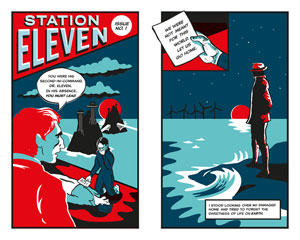WARNING: THESE PROJECT ASSIGNMENT PAGES CONTAIN A LOT OF IMPORTANT INFORMATION.
Do not skim. Read carefully. Maybe even print them out and mark them up.
Ignoring instructions or examples will cause you to waste time and become frustrated.
no spoiler alerts
Again, I am not going to spoil the book for you; as you are reading this you may just be begining the novel (I hope you take lots of notes!). Nevertheless, by the time you reach the end, you will see that there are obvious opportunities for a sequal (and, in fact, I would be surprised if Mandel is not writing one); if she does, that's fine. This will be your sequal.
"Sequel" sounds a bit daunting. After all, Station Eleven is over 300 pages long. No, I do not expect you to write a 300-page sequel. I do expect you to write somewhere in the neighborhood of just one dramatic scene (about eight-to-ten pages).
Do a little experiment to see just how little you can cover in eight-to-ten pages. Open Mandel's (or really anyone else's) novel to a page you found particularly exciting or engaging. Read about four pages (just four). The novel is single spaced, so it is roughly the same as your eight-to-ten-page double-spaced narrative. Not much goes on. You are trying to write like a writer, so really, you are going to get one short character interaction, one portion of one problem/conflict, which will not be resolved (more on that later).
Do not give a lot of backgorund about the first novel; just begin where your sequel begins, in the middle of action probably. Give us a scene or two involving a couple of character. You could look at what a couple of the original characters are doing after the events of the first novel; you might look at totally different characters in another part of the world (one writer looked at what happened to those people who took one of the airplanes west, for example). Is this further traveling? Does it take place later at the museum? The choice is yours.
Since so much of this book invites us to think about how to survive off the grid, you will want to work some element of that into the scene(s) you write. It does not have to be a lot, just a few setting details or actions suggesting how your characters are living (on the road, at the airport, in the town to the South, wherever).
Keep it lively. Give your reader a sense of character, of place, of situation (make it exciting perhaps?). Use lots of descriptive detail. Do not explain; write the narrative the way a novelist would write it. Also, do not try to tell a complete story; this is just a very small bit of a novel. It is a great idea to introduce a problem and not resolve it (that is called a cliff-hanger, and it leaves your reader wanting more).
warning: no silly zombie-clone stories
Yes, you do want to have some conflict, some obstacle, some tension in your story, but try to find a balance.
However, remember, please, that the book we read was not World War Z or 28 Days Later. Mandel's novel was the finalist for the National Book Award because it was not just a thriller-killer work. Don't do something silly like resurrect The Prophet, and as much as I applaud the storyline of The Last of Us, well, that has been done...lots. Just as the tribes want "the best" literature (they demand Shakespeare, for goodness sake), your reader wants something thought-provoking, not just provocative.
This is not really a spoiler; if you have not finished the book yet, this will not mean anything to you. In the last line, Clark "likes the thought of ships moving over the water, toward another world just out of sight" (Mandel 333).
That might give you an opening thought about how to shape your sequel. Since you (or your teammate) will be researching the creation of an off-the-grid community, what wonders might your characters come across as they enter "another world just out of sight"? Will it be the first logical steam punk community? It certainly could be a dangerous place. This community might fear the re-emergence of old ways (Clark wonders if he should stop telling the young about the past; it disturbs them).
Also remember that you are not limited to the characters given in the first novel. This could be a tale of something happening similtaneously to the events in Station Eleven, only in a very different part of the world. What might an isolated community on one of those huge container ships be like? You might have to modify your research a bit if you looked at that angle, and that's OK.
wait, wasn't there an option within this option?
Station Eleven - Graphic Fiction Project

Yes, you may turn this in as a conventional creative writing project (producing a scene for a sequel, a prequel, or a paraquel on paper, in MLA format); however, if you see yourself as more visual, hands-on artistic, you can do this same project as a portion of a comic book or graphic novel. The word count will go down, but the page count will not. You will still be producing an eight-to-ten-page portion of a comic (or a mini-comic) with anywhere from one (rare) to six (fairly conventional) on a page. Your text will be in the form of dialogue bubbles, thought bubbles, and captions, non-dialoge information, and so on.
There are a couple of different ways to handle this, and the finished paper could be done on paper, as PowerPoint panels, or on a website.
You can actually cover more story if you go with this option.
Do a little experiment and read eight pages of a comic book or graphic novel. Quite a lot can happen, about a whole chapter's worth compared to novel. A lot of the dynamic or tonal moments of a comic are expressed in the images; writers have to incorporate a lot more description to set a scene, describe action, etc.
I'm not sure if you see that as an advantage or a disadvantage, but your decision on which format to choose for your sequel/prequel/paraquel will depend largely on which you think is more fun or on which challenge you want to try more :)
one other option within this option (within this option)
In the past some students said they would rather complete the comic book that Miranda wrote in the novel, one of the two issues of the Dr. Eleven comic. After all, there are some tantalizing hints about what is in a few of the comic panels, and that story is never fully developed inside the novel.
If you like that instead of doing a comic about Kristen heading south or a character in California at the time of the Georgia flu or a couple of CDC technicians accidentally releasing a bio-toxin into the atmosphere before the original book takes place, then go for it. It's a fun option.
So, just to be clear, if you chose the Graphic Fiction option for your final project, you may write a sequel or prequel or paraquel to Mandel's novel, or you may instead fill in the blanks for the comic book about Dr. Eleven mentioned (quite a lot) inside of Mandel's novel
what you will turn in (and how)
As was noted in the pinkinsh sidebar box near the top, this project will be done in steps; there are three of them. Each step has a separate due date (see Class Schedule page). The first step requires you to make a choice.
1. sequel Project Proposal
Before you spend a great deal of time on the research, the invention, the writing, you will need to get a Project Proposal approved by me. Be sure you check the due date on the Class Schedule.
THIS IS VERY IMPORTANT: I will not accept your research paper or your final project if you have not had the Project Proposal approved. Then things roll down hill in a very unfortunate way--you will not get a score for this 200-point paper; you will not pass the class.
The proposal itself is not hard, but it does require you to have considered your options, to have thoroughly read and understood the project choices. The (short) proposal will be typed in MLA format. There will be more detailed information coming up soon on the Station Eleven Proposal Assignment page.
Simple enough. There are samples in the Files section on Canvas. There are separate ones for the conventional sequel and the comic book version.
2. the Research Paper
The research paper will be due a couple of weeks prior to the Final Project (due date is on the Class Schedule). It is absolutely required and is worth up to 100 points.
Writers want their work to feel real. Stephen King, for example, spent paragraphs describing a run down diner and its jukebox in his book Christine, and to get it just right, he studied an old diner, looked at the old jukebox. Writers do research.
One part of this project will have you do research on details you will use in your story to bring it to life, to make it feel authentic. You will use what you've researched for things like setting details and actions of your characters. There will be more detailed information coming up soon on the Station Eleven Research Paper Assignment page.
You can view samples in the Files section on Canvas.
3. the Final Project
The Final Project will be the sequel or comic itself. It will be about eight pages and is also worth up to 100 points.
As I noted above, "sequal" seems like a very hefty task. You are not expected to write several hundred pages (thank goodness), but how can you deliver an entire sequal to a novel in just eight pages.
Well, you can't.
About the most you can hope to do is a solid, interesting, dramatic chapter that gives a sense of one pivotal scene from your sequel. There will be more detailed information coming up soon on the Station Eleven Final Project Assignment page.
There are samples for all stages of this project on Canvas.
